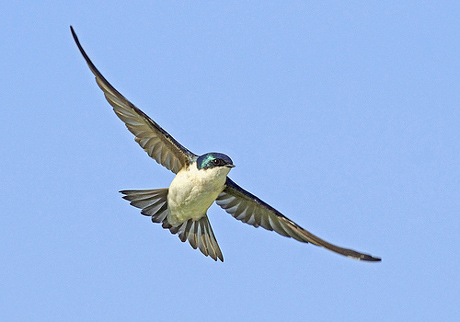
At Your Boxes:
By now you’ve had weeks to witness bird flight shown by Tree Swallows. You’ve seen them soar, dive, and dash about. You’ve watched them bank, wheel, turn, pivot, and hover. Their powers of flight are dazzling! Since they truly are masters of the air, how can a web site about Tree Swallows not attempt a page about bird flight? Photo above by Homer Caliwag.
Make it a point when you visit your project to devote some time to simply watching swallows fly. Observe the complexities of bird flight shown by your Tree Swallows. Watch how they hold and move their wings as they execute different maneuvers. And watch how other bird species fly. Compare their skills and techniques with the swallows’. How do you think body size, wing size, and wing shape influence each bird’s flying style?
Concepts:
To say flight is complex is a gross understatement. Flight involves a great many intricate interactions among a bird’s nerves, muscles, tendons, skeleton, and feathers. Almost every aspect of bird anatomy and physiology changed dramatically over time as their flying ability evolved. But though people have admired bird flight for thousands of years, it wasn’t until the 1980’s, when scientists were first able to make slow motion x-ray movies of birds flying in wind tunnels, that they truly began to understand just how all a bird’s parts worked together in flight. We caution you that our account of bird flight shown by Tree Swallows barely scratches the surface.
If you really want to learn about the physics of bird flight, in our opinion the chapter in the Handbook of Bird Biology, 3rd Ed., from the Cornell Lab of Ornithology is by far the best and most complete treatment of this fascinating subject.
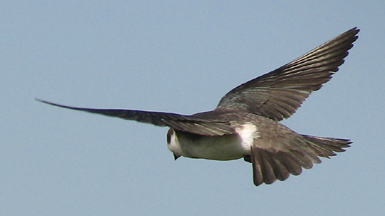
When you really consider it, flying seems an impossibly difficult thing to do. To fly, an animal must resist gravity and support itself in air, a movable, flexible, and not very supportive medium. And once airborne the animal must be able to both power and control its own movement. Many animals can glide, but of all the animals that have ever lived only insects, pterosaurs, birds, and bats have developed the ability to truly fly, evidence of flight’s difficulty. And to achieve something this hard the bodies and metabolisms of each of these groups had to undergo drastic modifications.
The most obvious adaptations for powered flight are wings.
- Powered flight requires wings of some kind, flattened surfaces to push against air, providing upward lift, forward thrust, and continuous control of movement.
- Beginning with the same basic ancestral forelimb bones pterosaurs, bats, and birds independently developed different types of wings.
- Pterosaurs, the oldest group of flying vertebrates, are now extinct. They flew with “finger wings,” where one finger of each hand was very long and supported a skin membrane reinforced by fibers.
- Bats fly with “hand wings.” Their hands and fingers are greatly enlarged, and connected by a thin, tough web of skin that serves as a flight surface.
- Birds developed a third kind of flying surface, “arm wings” (see below). Unlike bats and pterosaurs, bird hand and wrist bones are reduced, not enlarged. And instead of irreplaceable skin membranes, birds catch, move and ride air with the ultralight but strong, replaceable structures we call feathers.

- Flying conveys advantages. Flying animals can travel far to find the best living conditions at any given time. They can fly away from danger and can place their nests out of most harm’s way. And flying may help them as they search for and catch food. However, there are trade-offs.
- When they developed wings specialized for flight all three vertebrate groups lost or limited the use of their forelimbs for many other tasks.
Feathers themselves show many adaptions for flight.
- Feathers, the epitome of lightness, form a bird’s main flight surfaces.
- The large “flight feathers” of a bird’s wings and tail help propel, steer, and balance the bird as it moves through the air.
- The long flight feathers of the outer wing , the “primaries,” attach to the bird’s hand bones.
- The wing’s inner flight feathers, the “secondaries,” attach to the larger of a bird’s two forearm bones.
- Together, the primaries and secondaries are called the “remiges.”
- Primary and secondary wing feathers are not fixed rigidly in one place. Instead, they can twist or swivel when they move against the air.
- The “vanes” (the flat surfaces that protrude from each side of a flight feather’s shaft) of the secondaries and especially of the primaries are not the same size. The outer vane is smaller, the inner one broader (see below). This difference becomes very important during flapping flight.

- The smaller “contour feathers” on the bird’s head, body, and wings smooth and streamline its shape, so it can pass through air with less frictional drag.
- Some groups of these contour feathers, the “coverts,” partially overlap the wing and tail flight feathers, adding to the bird’s streamlining.
- Try distinguishing these feather groups in other pictures on this web site.
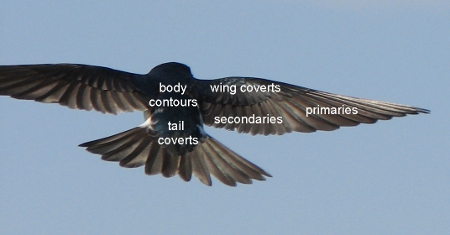
Birds have many other vital flight adaptations that aren’t obvious to us because they are internal.
Bird bodies are extremely modified for lightness and strength.
- Over millions of years many bird bones became smaller in size or were lost altogether.
- Most remaining bones are hollow, and have thin-walls reinforced with tiny cross-struts.
- Modern birds have only three fingers, and two of these are very tiny.
- Most of the bones in bird wrists are fused together.
- Many joints in bird spines, pelvis, and tails have been either eliminated or fused together for increased rigidity, lightness, and strength.
- Bird shoulder bones are modified to execute the unique wing movements necessary for flight.
- A bird’s main flight muscles are not out in the wings. They are concentrated in the chest and shoulders instead. These flight muscles can make up an amazing 30-50 percent of a bird’s total body weight.
- Bird sternums (breastbones) possess large flat “keels” where the flight muscles of the chest attach.
- Modern birds have lost the teeth their ancestors once possessed.
- Bird skin is very thin and light, but tough.
- Bird reproductive organs are tiny most of the year, enlarging only during mating season, and modern-day female birds have only one ovary.
Different bird flight methods require different levels of energy. For instance, soaring, gliding and bounding take less energy than sustained, rapid flapping.
Birds have adaptations that support metabolisms that are much more active than our own. These include:
- Hearts that are five times as large as ours as a percentage of body weight, and can pump ten times or more faster than ours.
- Many more oxygen-carrying red blood cells per ounce than non-flying animals.
- Ability to maintain high body temperatures while active.
- Digestive tracts adapted for rapid processing of large amounts of high-energy, fuel-providing foods.
But it’s in their breathing and heat-regulating systems that birds are most surprisingly and radically different from us.
- Bird flight muscles may demand large amounts of oxygen to fuel powered flight.
- This muscular exertion generates large amounts of waste heat that bird bodies must remove.
- Birds meet these related needs using a combination of lungs and air sacs, a system possessed by no other group of living animals.
- When we mammals inhale air into our lungs exchange oxygen and carbon dioxide in tiny dead-end sacs. Then the used air flows back out the exact same route. Our lungs never empty completely so stale exhaled air mixes with the next fresh breath, and we extract only a low percent of the oxygen available per breath.
How are bird breathing systems difference from ours?
- Birds have much more complex and efficient respiratory systems, in which a bird’s muscles and skeleton pump air through in a continuous one-way direction, not back and forth like ours. Birds’ one-way flow allows them to extract almost all the available oxygen from air they inhale.
- Bird lungs do not have tiny dead-end sacs like ours for gas exchange. Instead, air flows through tubes in bird lungs called “parabronchi,” where oxygen and carbon dioxide are exchanged across the walls of microscopic capillaries.
- And during a bird’s breathing cycle air passes not just through its lungs but also through a complex system of interconnected “air sacs.” Most birds have nine pairs of these thin-walled sacs. The sacs fill parts of their body cavities, and even penetrate their muscles and bones. A substantial part of a bird’s body is actually filled with air.
- As a bird flies its flight muscles and moving skeletal parts act like a bellows, rhythmically pumping air along through its lungs and air sacs. Oxygen and carbon dioxide don’t exchange in the air sacs. However routing air through them permits a bird’s one-way, rapid-ventilation, breathing system.
- Air sacs have still another vital function: dissipation of heat. As it flows through the sacs air picks up most of the excess heat a bird’s muscles generate during flight. When the bird exhales this heat is expelled from its body.
Flight has demanded drastic modifications in bird bodies, but what about flight itself? How do birds do it?
- Flight actually has three parts: takeoff from the ground or a perch, sustained powered flight, and landing. Each of these requires somewhat different actions by the bird. You should be able to observe all three of these aspects of bird flight in your Tree Swallows.
- The airfoil shape of bird wings helps. Wings are more curved on top than on the bottom, which means air passing around has to go a bit farther and faster over the top. This creates a pressure differential, with higher pressure below and lower pressure above the wing, that helps lift the bird’s body up.
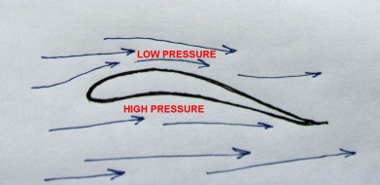
- Airfoils are a great advantage for gliding and soaring birds. However, continuous powered flight needs something more.
- True powered flight also requires a direct input of muscular force to get a bird into the air, keep it there, and propel it in a controlled manner in the direction it wants to go.
Taking off:
- Taking off from a standstill requires an immense generation of force, and since the bird isn’t moving forward through the air yet, it must use its own muscle power to lift itself up.
- A bird taking off typically makes a very exaggerated up-sweep, raising both wings high over its back (below left).
- The wings then drive downward with a long powerful stroke (below right) which lifts the bird into the air.
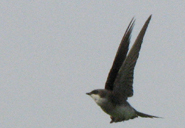
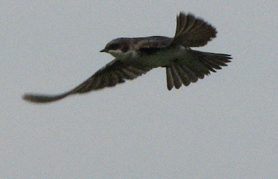
- Birds on elevated perches can takeoff more easily, by simply dropping off the perch, spreading their wings to create lift (below), and letting gravity and the wing’s airfoil shape provide the initial forward momentum.
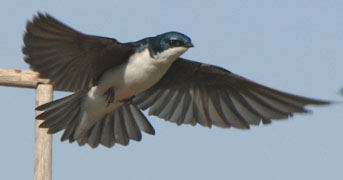
Sustaining powered flight:
- Once airborne, most birds must flap their wings at least occasionally in order to keep flying under their own power. This may seem simple enough, but flapping is actually a very complex, multi-part action.
- Flapping involves downstrokes, upstrokes, and transitions in between.
- And as birds flap they change the shape of their wings, pushing large wings down and raising small wings up. This is an essential aspect of bird flight.
- Note the various wing positions and relative surface area sizes of bird flight shown among the migrating Tree Swallows in Don Binder’s photo below.
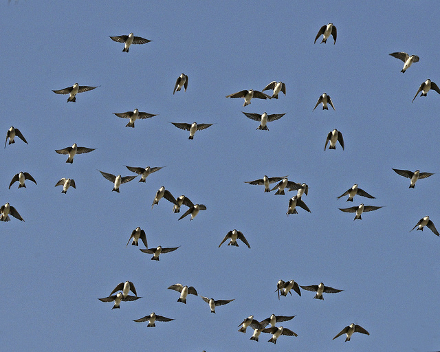
Downstrokes (or Powerstrokes):
- Birds generate most of the lift and forward propulsion of powered flight on the downstroke, driven primarily by the “pectoralis muscles” of the chest.
- As you would expect, the pectoralis are the largest and most powerful muscles in a flying bird’s body.
- At the start of downstrokes a bird stretches its wings out fully and extends them forward, creating a large surface area (see below).
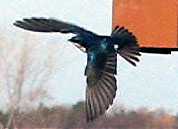
- Next, the pectoralis muscles contact, pulling these “large wings” down against the resisting air.
- As each wing thrusts down its flight feathers overlap. The wider vane on each feather’s shaft pushes more air and, because these flight feathers are free to move, each wide vane twists up until it meets the small vane on the next feather. This shapes the wing into one big, broad, flat airfoil unit, as in the simplified cross-section below.

- Each downstroke with the airfoil shaped wing propels the bird forward. The strong flexible primary feathers provide most of the downstroke’s power and the secondaries provide most of the lift.
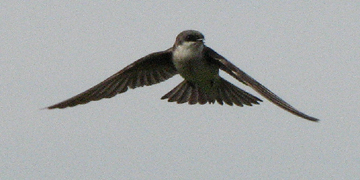
Upstrokes (or Recovery Strokes):
- Once a wing completes one downstroke it needs to be raised back up and re-positioned before it can make another downstroke.
- Birds power upstrokes using their “supracoracoideus muscles.” These are located on the bird’s chest underneath the pectoralis muscles, not on its back as one might think.
- Birds have a couple of techniques to make their wing profiles smaller, to produce an efficient upstroke.
- Many birds flex or fold their wings slightly on upstrokes (see below). This reduces the wing’s surface, so there is less area pressing against air.
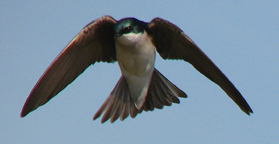
- Now, the asymmetry of the flight feather vanes and the feathers’ freedom to twist, which allowed them to form large wings on the downstroke, come in handy again.
- On upstrokes wing flight feathers pivot again but in the other direction, creating many open slots air can pass through with little resistance.

- The swallow below shows both wing flexing and slots between its primaries as it upstrokes with “small surface wings.”
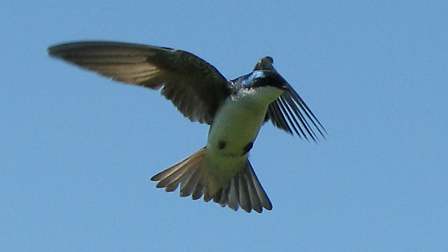
What’s the tail’s main role in bird flight?
- Bird tails don’t flap. In flight they coordinate with the wings or operate semi-independently, depending on circumstances.
- During steady, straightforward flight the tail doesn’t have much to do.
- But when a bird must turn or when air turbulence threatens to knock the bird around, movements of the stiff tail feathers, its “rectrices,” help the bird steer like a rudder to maintain directional control.

Landing:
- Eventually flying birds must land. To do this successfully they must slow down dramatically while maintaining enough control to avoid crashing.
- Many birds accomplish this by making deep wing beats and fanning their tails to decelerate, then throwing their legs forward to absorb impact and contact the landing surface.
- Photo below by Don Christian of SouthernShots21.
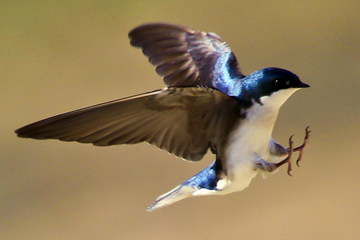
- Some situations allow birds to swoop up as they land (see below), which lets gravity help slow their forward momentum.

- After all the years we’ve watched we are still amazed by the intricacies of bird flight our Tree Swallows illustrate!
Questions for the next Topic: Mating in Tree Swallows
Tree Swallow DNA studies show the resident female is almost always the mother of all the young in her nest. However, her resident male partner often is not the father of all young in his nest. What’s going on here?
- Are extra-pair males forcing some females to copulate with them, and if so, why would males want to do this?
- Are some females “cheating” on their mates, and if so, why would females want to do this?
- What could a resident male Tree Swallow do to make sure he will be the father of at least some of the young in his nest?
————————————————————————————–
Home: Tree Swallow Nest Box Projects
Creating Tree Swallow Nest Box Projects
Spring Return
Nesting Season Behavior
Song and Calls
Nest Site Claiming
Pair Formation
Nest Building
Bird Flight
Mating and Paternity
Diary of One Season at Salmon Creek
Monitoring Nest Boxes and Keeping Records
Making Box Checks Keeping Box Records Control Sheets Season Summaries Print Sheets
Banding Your Tree Swallows Banding Adults Banding Nestlings
Tree Swallows in Research Research Bibliography Glossary of Terms